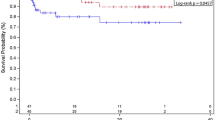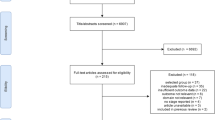Abstract
The purpose of this study was to compare the incidence of reinfection in patients who received oral antibiotic prophylaxis with those who did not following two-stage revision knee arthroplasty. Additional purposes included: (1) comparison of these findings to the infection rate in patients who underwent revision for aseptic reasons, and (2) characterisation of the organisms responsible for reinfection following revision procedures. Twenty-eight two-stage revision knee arthroplasty procedures were followed up by a mean of 33 days of oral antibiotics (range, 28–43 days), while the remaining 38 procedures received only 24–72 hours of in-patient antibiotics. The incidence of reinfection in each group within 12 months was compared. The reinfection rates were additionally compared to those of 237 patients who underwent revision for aseptic loosening over the same time period. Patients who were treated with postoperative antibiotic prophylaxis had a considerably lower reinfection rate, with one reinfection in the prophylaxis group (4%), compared to six reinfections in the no-prophylaxis group (16%). The reinfection rates remained higher compared to those found in patients who underwent revision knee arthroplasty for aseptic loosening (1 of 237 patients; 0.4%). Both high and low virulence organisms were identified in the patients who were subsequently reinfected. A minimum of 28 days of postoperative oral antibiotics appeared to decrease reinfection rates following two-stage revision knee arthroplasty. These results suggest that the use of oral antibiotic prophylaxis following re-implantation may be appropriate in all patients undergoing two-stage revision, even in the absence of any signs of active infection.


Similar content being viewed by others
References
Alexander JW, Aerni S, Plettner JP (1985) Development of a safe and effective one-minute preoperative skin preparation. Arch Surg 120:1357–1361
Barrack RL, Engh G, Rorabeck C, Sawhney J, Woolfrey M (2000) Patient satisfaction and outcome after septic versus aseptic revision total knee arthroplasty. J Arthroplasty 15:990–993. doi:10.1054/arth.2000.16504
Buechel FF Sr, Buechel FF Jr, Pappas MJ, Dalessio J (2002) Twenty-year evaluation of the New Jersey LCS rotating platform knee replacement. J Knee Surg 15:84–89
Cordero-Ampuero J, Esteban J, Garcia-Cimbrelo E, Munuera L, Escobar R (2007) Low relapse with oral antibiotics and two-stage exchange for late arthroplasty infections in 40 patients after 2–9 years. Acta Orthop 78:511–519. doi:10.1080/17453670710014167
Fehring TK, Odum S, Calton TF, Mason JB (2000) Articulating versus static spacers in revision total knee arthroplasty for sepsis. The Ranawat Award. Clin Orthop Relat Res 380:9–16
Goldman RT, Scuderi GR, Insall JN (1996) 2-stage reimplantation for infected total knee replacement. Clin Orthop Relat Res 331:118–124
Haleem AA, Berry DJ, Hanssen AD (2004) Mid-term to long-term followup of two-stage reimplantation for infected total knee arthroplasty. Clin Orthop Relat Res 428:35–39
Hanssen AD, Rand JA (1999) Evaluation and treatment of infection at the site of a total hip or knee arthroplasty. Instr Course Lect 48:111–122
Hanssen AD, Trousdale RT, Osmon DR (1995) Patient outcome with reinfection following reimplantation for the infected total knee arthroplasty. Clin Orthop Relat Res 321:55–67
Hart WJ, Jones RS (2006) Two-stage revision of infected total knee replacements using articulating cement spacers and short-term antibiotic therapy. J Bone Joint Surg Br 88:1011–1015. doi:10.1302/0301-620X.88B8.17445
Hebert CK, Williams RE, Levy RS, Barrack RL (1996) Cost of treating an infected total knee replacement. Clin Orthop Relat Res 331:140–145
Hoad-Reddick DA, Evans CR, Norman P, Stockley I (2005) Is there a role for extended antibiotic therapy in a two-stage revision of the infected knee arthroplasty? J Bone Joint Surg Br 87:171–174
Hofmann AA, Goldberg T, Tanner AM, Kurtin SM (2005) Treatment of infected total knee arthroplasty using an articulating spacer: 2- to 12-year experience. Clin Orthop Relat Res:125–131
Ilahi OA, Al-Habbal GA, Bocell JR, Tullos HS, Huo MH (2005) Arthroscopic debridement of acute periprosthetic septic arthritis of the knee. Arthroscopy 21:303–306. doi:10.1016/j.arthro.2004.10.010
Kurtz SM, Lau E, Schmier J, Ong KL, Zhao K, Parvizi J (2008) Infection burden for hip and knee arthroplasty in the United States. J Arthroplasty 23:984–991. doi:10.1016/j.arth.2007.10.017
Kurtz SM, Ong KL, Lau E, Bozic KJ, Berry D, Parvizi J (2009) Prosthetic joint infection risk after TKA in the medicare population. Clin Orthop Relat Res. doi: 10.1007/s11999-009-1013-5
Lachiewicz PF, Soileau ES (2009) Fifteen-year survival and osteolysis associated with a modular posterior stabilized knee replacement. A concise follow-up of a previous report J Bone Joint Surg Am 91:1419–1423. doi:10.2106/JBJS.H.01351
Leone JM, Hanssen AD (2005) Management of infection at the site of a total knee arthroplasty. J Bone Joint Surg Am 87:2335–2348
Lidwell OM, Lowbury EJ, Whyte W, Blowers R, Stanley SJ, Lowe D (1982) Effect of ultraclean air in operating rooms on deep sepsis in the joint after total hip or knee replacement: a randomised study. Br Med J (Clin Res Ed) 285:10–14
Mont MA, Waldman B, Banerjee C, Pacheco IH, Hungerford DS (1997) Multiple irrigation, debridement, and retention of components in infected total knee arthroplasty. J Arthroplasty 12:426–433
Nickinson RS, Board TN, Gambhir AK, Porter ML, Kay PR (2009) The microbiology of the infected knee arthroplasty. Int Orthop. doi: 10.1007/s00264-009-0797-y
Oussedik SI, Haddad FS (2008) The use of linezolid in the treatment of infected total joint arthroplasty. J Arthroplasty 23:273–278. doi:10.1016/j.arth.2007.03.022
Park SJ, Song EK, Seon JK, Yoon TR, Park GH (2009) Comparison of static and mobile antibiotic-impregnated cement spacers for the treatment of infected total knee arthroplasty. Int Orthop. doi: 10.1007/s00264-009-0907-x
Ritter MA, Berend ME, Meding JB, Keating EM, Faris PM, Crites BM (2001) Long-term followup of anatomic graduated components posterior cruciate-retaining total knee replacement. Clin Orthop Relat Res 388:51–57
Sculco TP (1993) The economic impact of infected total joint arthroplasty. Instr Course Lect 42:349–351
Sierra RJ, Cooney WPt, Pagnano MW, Trousdale RT, Rand JA (2004) Reoperations after 3200 revision TKAs: rates, etiology, and lessons learned. Clin Orthop Relat Res 425:200–206
Silva M, Tharani R, Schmalzried TP (2002) Results of direct exchange or debridement of the infected total knee arthroplasty. Clin Orthop Relat Res 404:125–131
Waldman BJ, Hostin E, Mont MA, Hungerford DS (2000) Infected total knee arthroplasty treated by arthroscopic irrigation and debridement. J Arthroplasty 15:430–436. doi:10.1054/arth.2000.4637
Wang CJ, Hsieh MC, Huang TW, Wang JW, Chen HS, Liu CY (2004) Clinical outcome and patient satisfaction in aseptic and septic revision total knee arthroplasty. Knee 11:45–49
Windsor RE, Insall JN, Urs WK, Miller DV, Brause BD (1990) Two-stage reimplantation for the salvage of total knee arthroplasty complicated by infection. Further follow-up and refinement of indications. J Bone Joint Surg Am 72:272–278
Conflict of interest
No external funding was provided in support of this study. The authors certify that they have full control of all primary data and agree to allow the journal to review the data if requested.
Author information
Authors and Affiliations
Corresponding author
Rights and permissions
About this article
Cite this article
Zywiel, M.G., Johnson, A.J., Stroh, D.A. et al. Prophylactic oral antibiotics reduce reinfection rates following two-stage revision total knee arthroplasty. International Orthopaedics (SICOT) 35, 37–42 (2011). https://doi.org/10.1007/s00264-010-0992-x
Received:
Revised:
Accepted:
Published:
Issue Date:
DOI: https://doi.org/10.1007/s00264-010-0992-x




